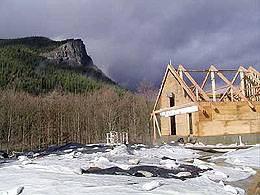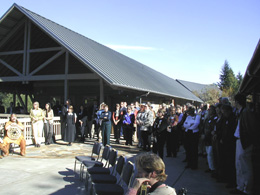This slideshow documents the opening of the Cedar River Education Center, located in eastern King County on Rattlesnake Lake, on October 2, 2001. Written and photographed by Alan Stein and sponsored by Seattle Public Utilities with Friends of the Cedar River Watershed.
Cedar River Education Center -- Slideshow
- By Alan J. Stein
- Posted 10/04/2001
- HistoryLink.org Essay 7037

One month after Seattle's Great Fire of 1889, Seattle voters approved the creation of a municipal water system using the Cedar River watershed. Work camps soon sprung up near Cedar Falls along Rattlesnake Lake. In 1901, the first drinking water reached Seattle.
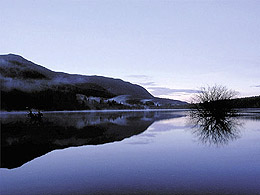
In 1996, a land exchange with the USDA Forest Service gave Seattle sole ownership of all lands in the watershed. The same year, the Friends of the Cedar River Watershed (FCRW), a private, non-profit organization dedicated to the protection and enhancement of the watershed, was incorporated.

The priority project of the FCRW was the creation of the Cedar River Watershed Education Center. FCRW and Seattle Public Utilties formed a partnership to construct a first-class cultural and environmental education center for use by all residents and visitors in the Puget Sound area. The education center would provide environmental education programs to more than 30,000 school children each year, and would provide organizations, businesses, and families the opportunity to learn more about the watershed and its role in the region's ecosystem.

Groundbreaking ceremonies were held on March 31, 2000, along the shore of Rattlesnake Lake. Seattle Mayor Paul Schell helped members of the FCRW dig the first spadefuls of dirt.
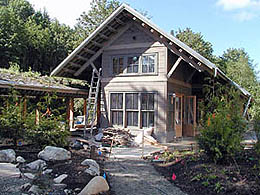
By the end of summer most of the structures and landscaping were complete. On October 2, 2001, dedication ceremonies were held for the $6.8 million Education Center.
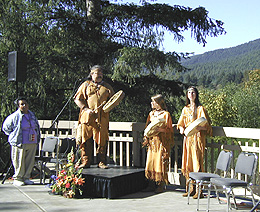
Snoqualmie Tribal Council Member Ray Mullen and other members of the tribe gave the welcoming invocation.
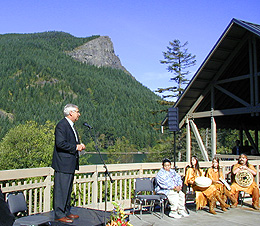
Seattle Mayor Paul Schell was the main speaker for the event, and also introduced other speakers and dignitaries.
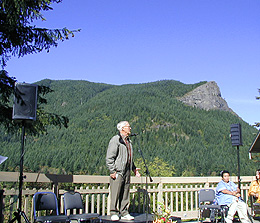
Jim Ellis, co-founder of the Mountains to Sound Greenway Trust, spoke of the importance of environmental education.
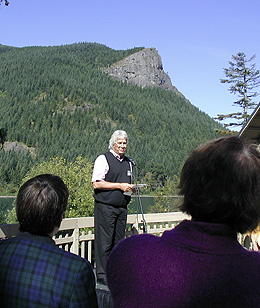
Architecture and landscaping for the Cedar River Watershed Education Center were created through Seattle-based Jones and Jones Architects. Architect Johnpaul Jones told of the efforts to integrate the design with the natural enivronment.

The Education Center is located at the site of the railroad camp used by watershed workers in the early part of the twentieth century. These maple trees once stood in front of a row of cabins, but now surround a pathway leading to the Center.

Care was taken to merge the Center with the surrounding environment. Here, two buildings are connected by a walkway which spans a stream.
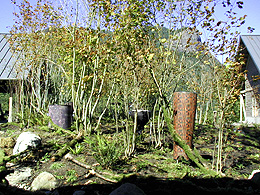
Local artist Dan Corson provided special touches to the center. In the Forest Court, Corson arranged a ring of drums which sound when hit by rain. On rainless days, calibrated water droplets play on the drumheads via a computerized irrigation system. Thin pipes hidden in the foliage send droplets to each drum in syncopation, and can be programmed to play a variety of international rhythms.
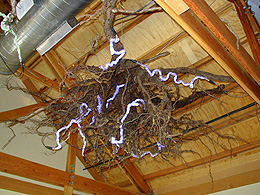
Corson also created hanging sculptures made out of root balls dug from the watershed. The clusters were cleaned and fumigated, then interlaced with strands of neon that mimic the flow of water.
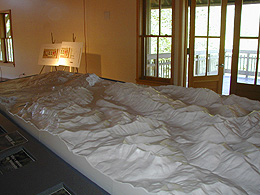
As of the dedication ceremony, some exhibits were still under construction. This 3-D model of the entire watershed will come alive with interactive overlays of light and images when completed in 2002.

The goal of the Center is to help visitors understand the complex issues surrounding the future of the region's drinking water, forests, and wildlife. When complete, it will make available the collected artifacts and 9,400 year history of human activity in the watershed. It will have a learning laboratory where students and scientists will explore the science of the watershed, and it will host conferences, retreats, and programs fostering public dialogue to meet environmental stewardship challenges.
Licensing: This essay is licensed under a Creative Commons license that encourages reproduction with attribution. Credit should be given to both HistoryLink.org and to the author, and sources must be included with any reproduction. Click the icon for more info. Please note that this Creative Commons license applies to text only, and not to images. For more information regarding individual photos or images, please contact the source noted in the image credit.


